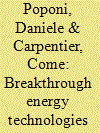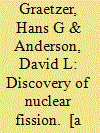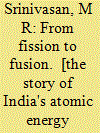|
|
|
Sort Order |
|
|
|
Items / Page
|
|
|
|
|
|
|
| Srl | Item |
| 1 |
ID:
122813


|
|
|
| 2 |
ID:
042994


|
|
|
|
|
| Publication |
New York, Van Nostrand Reinhold Company, 1971.
|
| Description |
vii,120p.
|
|
|
|
|
|
|
|
|
|
|
|
Copies: C:1/I:0,R:0,Q:0
Circulation
| Accession# | Call# | Current Location | Status | Policy | Location |
| 007362 | 539.762/CRA 007362 | Main | On Shelf | General | |
|
|
|
|
| 3 |
ID:
046376


|
|
|
|
|
| Publication |
New Delhi, Viking Books, 2002.
|
| Description |
xviii, 318p.
|
| Standard Number |
9780670049247
|
|
|
|
|
|
|
|
|
|
|
|
Copies: C:1/I:0,R:0,Q:0
Circulation
| Accession# | Call# | Current Location | Status | Policy | Location |
| 046391 | 539.760954/SRI 046391 | Main | On Shelf | General | |
|
|
|
|
| 4 |
ID:
075376


|
|
|
|
|
| Publication |
2006.
|
| Summary/Abstract |
The potential role of nuclear fission to meet increased future energy demand while reducing greenhouse gas emissions and controlling nuclear proliferation is assessed. The World Energy Council projection for an environmentally driven future is used, which projects deployment of nearly 3 TW(e) of nuclear generation by 2100, with concurrent reduction of global CO2 emissions to one-third of present levels. We simulate three scenarios based on this demand curve that rely on evolutionary and advanced systems of reactors. The scenarios differ only in fuel cycle choice between once-through, transmutation, and breeding. We show that the cost of nuclear power will likely remain a minimum using the once through fuel cycle, which, we argue, also minimizes proliferation risks. The other two fuel cycle choices have the benefits of decreased waste production and increased uranium resource utilization, but these come at a price that is probably not acceptable unless the cost of repository space increases dramatically, or the cost of building advanced transmuting or breeding reactors can be reduced to a level lower than that of constructing new plants with contemporary technology. The importance of choice of discount rate in allocating resources to advanced nuclear technologies is discussed. The linkage of fuel cycle choice with the international non-proliferation regime is emphasized.
|
|
|
|
|
|
|
|
|
|
|
|
|
|
|
|
| 5 |
ID:
101763


|
|
|
|
|
| Publication |
2010.
|
| Summary/Abstract |
Antineutrinos are electrically neutral, nearly massless fundamental particles produced in large numbers in the cores of nuclear reactors and in nuclear explosions. In the half century since their discovery, major advances in the understanding of their properties, and in detector technology, have opened the door to a new discipline-Applied Antineutrino Physics. Because antineutrinos are inextricably linked to the process of nuclear fission, there are many applications of interest in nuclear nonproliferation. This paper presents a comprehensive survey of applied antineutrino physics relevant for nonproliferation, summarizes recent advances in the field, describes the overlap of this nascent discipline with other ongoing fundamental and applied antineutrino research, and charts a course for research and development for future applications. It is intended as a resource for policymakers, researchers, and the wider nuclear nonproliferation community.
|
|
|
|
|
|
|
|
|
|
|
|
|
|
|
|
|
|
|
|
|